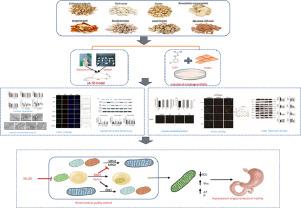Background
Xiang Sha Liu Junzi decoction (XSLJZD) is a famous traditional Chinese medicinal prescription for the treatment of functional dyspepsia (FD) in spleen deficiency. However, its therapeutic mechanism has not been fully clarified.
Purpose
The present study aimed to determine the role of mitochondrial quality control (MQC)-mediated gastrointestinal motility disorder in FD treated with XSLJZD by using spleen-deficient FD rats and gastrointestinal smooth muscle cells (GSMCs).
Methods
In vivo, an FD with spleen deficiency syndrome model was established by gastric perfusion with iodoacetamide solution combined with the modified multiple platform method (MMPM), followed by intragastric gavage with XSLJZD for 4 weeks. Improvement of pathological symptoms was evaluated based on food intake, water intake, grip strength, gastric histopathological changes, gastric emptying rate, small intestinal propulsion rate, and average amplitude and frequency of smooth muscle strips. The mitochondrial ultrastructure was observed by transmission electron microscopy. The colocalization of LC3 and Parkin with mitochondria was detected by immunofluorescence. The expression and localization of Drp1 proteins were detected by immunohistochemistry. In vitro, GSMCs were treated with different concentrations of XSLJZD-CS for 24 h, followed by treatment with 20 μM carbon cyanide 3-chlorophenylhydrazone (CCCP) for 4 h. Cell viability, mitochondrial membrane potential (MMP), mitochondrial reactive oxygen species (mtROS), cellular ATP generation and mitochondrial Keima (mtKeima) expression were examined. Both in vivo and in vitro, gene expression was assessed by Western blotting. All experiments were performed in duplicate.
Results
Disorders of the mitochondrial quality control system existed in gastric smooth muscle in FD spleen deficiency syndrome. XSLJZD administration promoted the contraction of gastric smooth muscle and restored mitochondrial function by downregulating the colocalization of LC3 or Parkin with mitochondria, reducing the ratio of LC3II/LC3I, decreasing the expression of PINK1, Parkin and Drp1 and increasing the expression of p62 to restore mitochondrial morphology and function. In vitro studies showed that the improvement in mitochondrial function by XSLJZD was related to PINK1-parkin-mediated mitochondrial quality control.
Conclusion
We demonstrated that XSLJZD can improve gastrointestinal motility disorder in functional dyspepsia with spleen deficiency syndrome, which was related to reconstruction of the mitochondrial quality control system by restraining PINK1/Parkin-mediated mitophagy and division. This study illustrates a novel clinical significance of herbal medicine in the treatment of FD and clarifies the important role of MQC in treating gastrointestinal motility disorder.









































 京公网安备 11010802027423号
京公网安备 11010802027423号